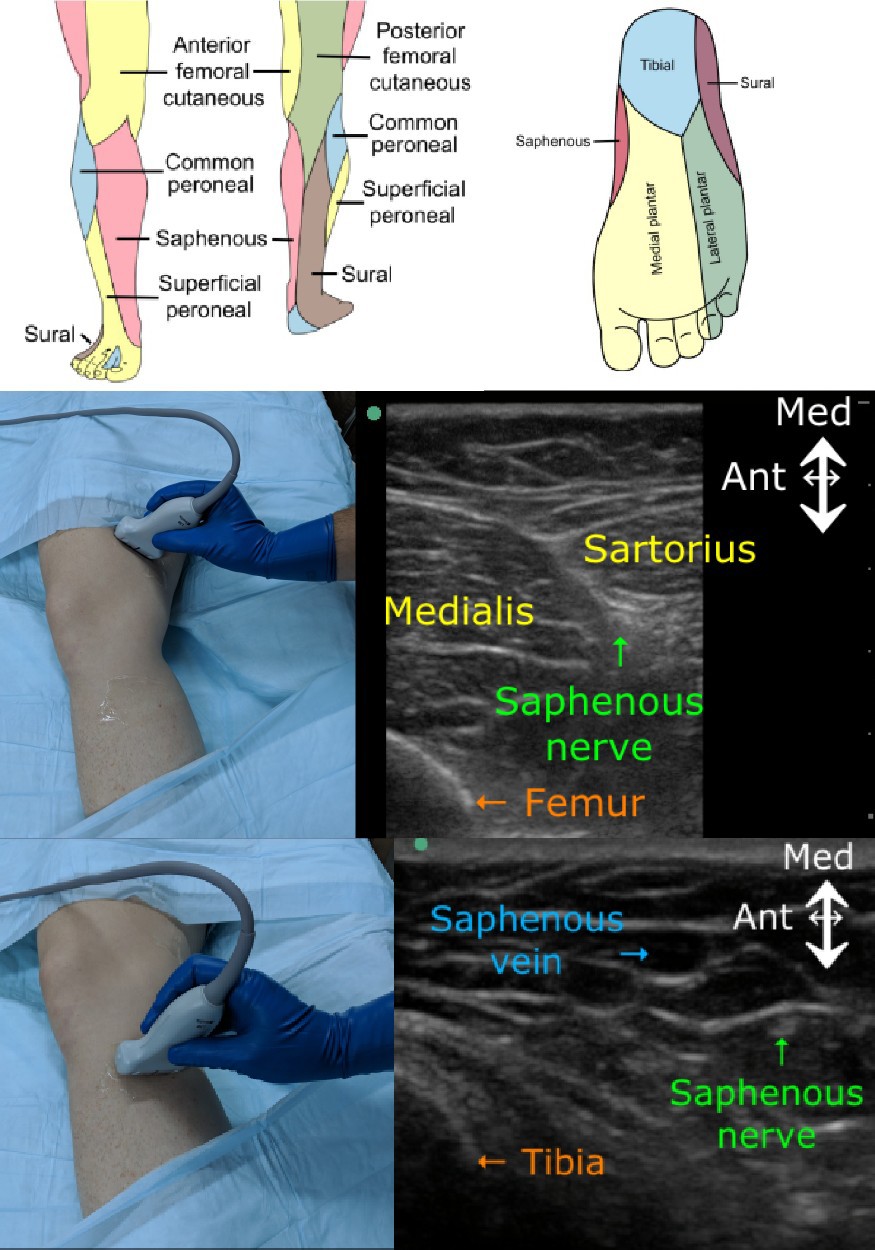[1]
Marsland D, Dray A, Little NJ, Solan MC. The saphenous nerve in foot and ankle surgery: its variable anatomy and relevance. Foot and ankle surgery : official journal of the European Society of Foot and Ankle Surgeons. 2013 Jun:19(2):76-9. doi: 10.1016/j.fas.2012.10.007. Epub 2012 Dec 27
[PubMed PMID: 23548446]
[2]
Horn JL, Pitsch T, Salinas F, Benninger B. Anatomic basis to the ultrasound-guided approach for saphenous nerve blockade. Regional anesthesia and pain medicine. 2009 Sep-Oct:34(5):486-9. doi: 10.1097/AAP.0b013e3181ae11af. Epub
[PubMed PMID: 19920424]
[3]
Marian AA, Ranganath Y, Bayman EO, Senasu J, Brennan TJ. A Comparison of 2 Ultrasound-Guided Approaches to the Saphenous Nerve Block: Adductor Canal Versus Distal Transsartorial: A Prospective, Randomized, Blinded, Noninferiority Trial. Regional anesthesia and pain medicine. 2015 Sep-Oct:40(5):623-30. doi: 10.1097/AAP.0000000000000277. Epub
[PubMed PMID: 26110441]
Level 1 (high-level) evidence
[4]
Manickam B, Perlas A, Duggan E, Brull R, Chan VW, Ramlogan R. Feasibility and efficacy of ultrasound-guided block of the saphenous nerve in the adductor canal. Regional anesthesia and pain medicine. 2009 Nov-Dec:34(6):578-80
[PubMed PMID: 19916251]
Level 2 (mid-level) evidence
[5]
Walter WR, Burke CJ, Adler RS. Ultrasound-guided therapeutic injections for neural pathology about the foot and ankle: a 4 year retrospective review. Skeletal radiology. 2017 Jun:46(6):795-803. doi: 10.1007/s00256-017-2624-7. Epub 2017 Mar 16
[PubMed PMID: 28303298]
Level 2 (mid-level) evidence
[6]
Krombach J, Gray AT. Sonography for saphenous nerve block near the adductor canal. Regional anesthesia and pain medicine. 2007 Jul-Aug:32(4):369-70
[PubMed PMID: 17720129]
[7]
Saranteas T, Anagnostis G, Paraskeuopoulos T, Koulalis D, Kokkalis Z, Nakou M, Anagnostopoulou S, Kostopanagiotou G. Anatomy and clinical implications of the ultrasound-guided subsartorial saphenous nerve block. Regional anesthesia and pain medicine. 2011 Jul-Aug:36(4):399-402. doi: 10.1097/AAP.0b013e318220f172. Epub
[PubMed PMID: 21697687]
[8]
Gray AT, Collins AB. Ultrasound-guided saphenous nerve block. Regional anesthesia and pain medicine. 2003 Mar-Apr:28(2):148; author reply 148
[PubMed PMID: 12677627]
[9]
Fredrickson MJ, White R, Danesh-Clough TK. Low-volume ultrasound-guided nerve block provides inferior postoperative analgesia compared to a higher-volume landmark technique. Regional anesthesia and pain medicine. 2011 Jul-Aug:36(4):393-8. doi: 10.1097/AAP.0b013e31821e2fb7. Epub
[PubMed PMID: 21610557]
[10]
Thiranagama R. Nerve supply of the human vastus medialis muscle. Journal of anatomy. 1990 Jun:170():193-8
[PubMed PMID: 2254163]
[11]
Abdallah FW, Whelan DB, Chan VW, Prasad GA, Endersby RV, Theodoropolous J, Oldfield S, Oh J, Brull R. Adductor Canal Block Provides Noninferior Analgesia and Superior Quadriceps Strength Compared with Femoral Nerve Block in Anterior Cruciate Ligament Reconstruction. Anesthesiology. 2016 May:124(5):1053-64. doi: 10.1097/ALN.0000000000001045. Epub
[PubMed PMID: 26938989]
[12]
Davis JJ, Bond TS, Swenson JD. Adductor canal block: more than just the saphenous nerve? Regional anesthesia and pain medicine. 2009 Nov-Dec:34(6):618-9. doi: 10.1097/AAP.0b013e3181bfbf00. Epub
[PubMed PMID: 19901788]
[13]
Jaeger P, Nielsen ZJ, Henningsen MH, Hilsted KL, Mathiesen O, Dahl JB. Adductor canal block versus femoral nerve block and quadriceps strength: a randomized, double-blind, placebo-controlled, crossover study in healthy volunteers. Anesthesiology. 2013 Feb:118(2):409-15. doi: 10.1097/ALN.0b013e318279fa0b. Epub
[PubMed PMID: 23241723]
Level 1 (high-level) evidence
[14]
Kwofie MK, Shastri UD, Gadsden JC, Sinha SK, Abrams JH, Xu D, Salviz EA. The effects of ultrasound-guided adductor canal block versus femoral nerve block on quadriceps strength and fall risk: a blinded, randomized trial of volunteers. Regional anesthesia and pain medicine. 2013 Jul-Aug:38(4):321-5. doi: 10.1097/AAP.0b013e318295df80. Epub
[PubMed PMID: 23788068]
Level 1 (high-level) evidence

